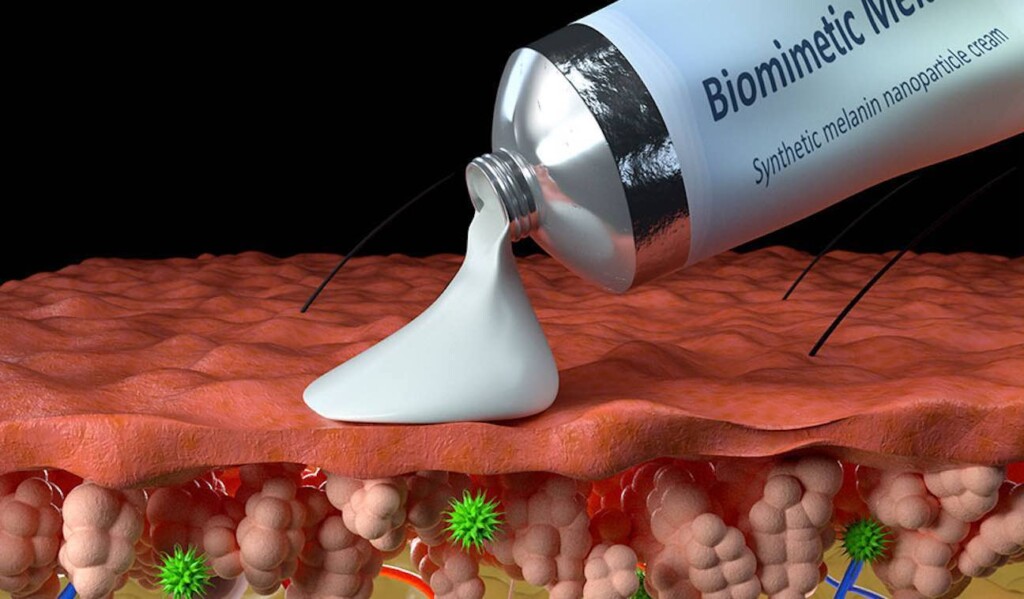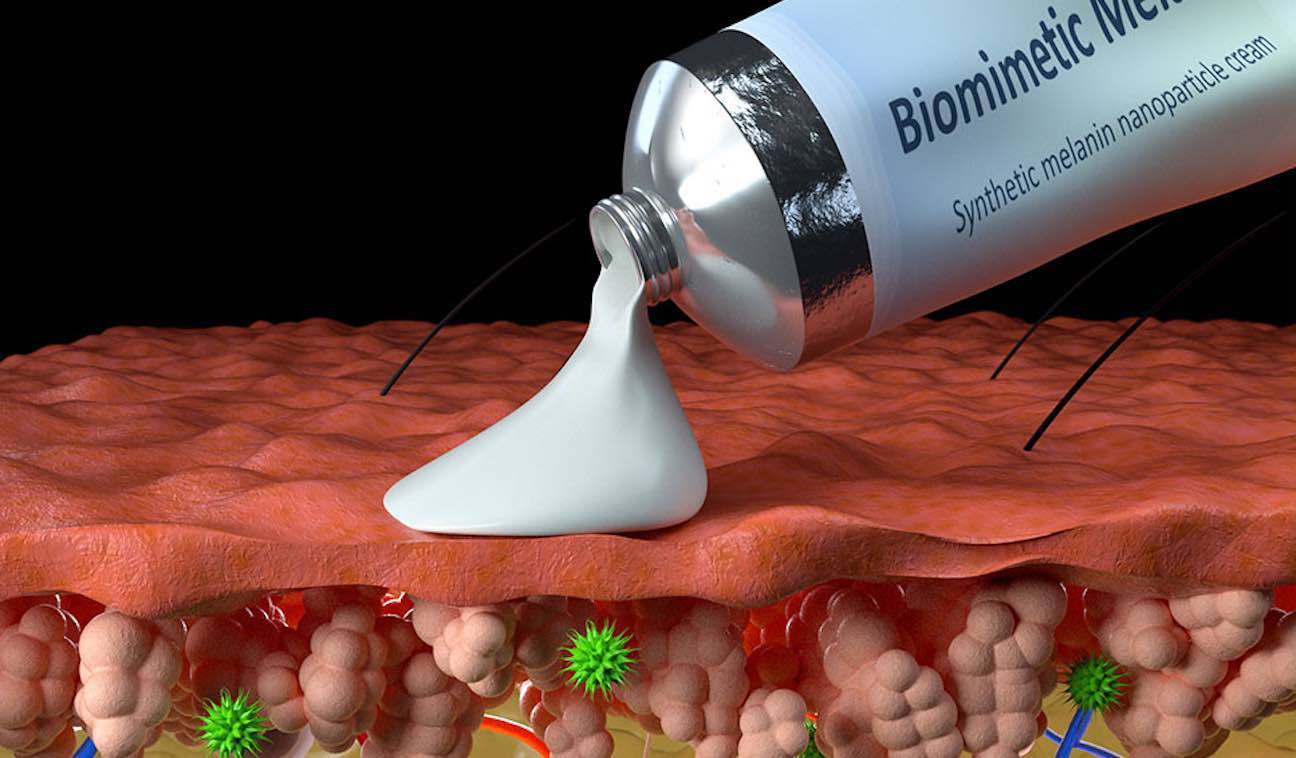
A new ‘super melanin’ skin cream developed by scientists at Northwestern University shows the ability to continuously heal sun damage and chemical burns.
The synthetic, biomimetic melanin cream demonstrated the potential to heal damage occurring throughout the day when skin is exposed to sunlight or environmental toxins.
It mimicks the natural melanin in human skin, and can be applied topically to injured skin, where it accelerates wound healing. These effects occur both in the skin itself and systemically in the body.
A study published this week in Nature Regenerative Medicine showed that when applied in a cream, the synthetic melanin can protect skin from sun exposure and heal skin injured by sun damage or chemical burns. The technology works by scavenging free radicals, which are produced by injured skin such as a sunburn. Left unchecked, free radical activity damages cells and ultimately may result in skin aging and skin cancer.
Melanin in humans and animals provides pigmentation to the skin, eyes and hair. The substance protects your cells from sun damage with increased pigmentation whenever the sun is ‘tanning’. That same pigment in your skin also naturally scavenges free radicals in response to damaging environmental pollution from industry smokestacks and car exhaust fumes.
“People don’t think of their everyday life as an injury to their skin,” said co-corresponding author Dr. Kurt Lu, who teaches dermatology and practices at Northwestern University School of Medicine. “If you walk barefaced every day in the sun, you suffer a low-grade, constant bombardment of ultraviolet light. This is worsened during peak mid-day hours and the summer season.”
The skin, which doesn’t age when protected by clothing, always does age due to getting older and external environmental factors, including air pollution.
“All those insults to the skin lead to free radicals which cause inflammation and break down the collagen,” Lu said. “That’s one of the reasons older skin looks very different from younger skin.”
When the scientists created the synthetic melanin engineered nanoparticles, they modified the melanin structure to have higher free-radical scavenging capacity.
MORE GOOD SKIN: Breakthrough Skin Treatment For ‘Butterfly Children’ is Pending FDA Approval After Excellent Trial Results
“The synthetic melanin is capable of scavenging more radicals per gram compared to human melanin,” said co-corresponding author Nathan Gianneschi, a professor of chemistry and pharmacology at Northwestern. “It’s like super melanin. It’s biocompatible, degradable, nontoxic and clear when rubbed onto the skin. In our studies, it acts as an efficient sponge, removing damaging factors and protecting the skin.”
The sunscreen booster stays on the surface and quiets immune system
Once applied to the skin, the melanin sits on the surface and is not absorbed into the layers below.
“The synthetic melanin stabilizes and sets the skin on a healing pathway, which we see in both the top layers and throughout the body,” Gianneschi said.
The scientists, who have been studying melanin for nearly 10 years, first tested their synthetic melanin as a sunscreen—and it was successful.
“Next, we wondered if the synthetic melanin, which functions primarily to soak up radicals, could be applied topically after a skin injury and have a healing effect on the skin?” Gianneschi said. “It turns out to work exactly that way.”
“You are protecting the skin and repairing it simultaneously,” Lu said. It’s continuous repair, as shown in the team’s video below…
The cream could also potentially be used for blisters and open sores, while quieting the immune system.
CHECK OUT: Hydrolyzed Collagen Supplements Are Good for Health: Benefitting Hair, Skin, Joints, and Muscles
The stratum corneum, the outer layer of mature skin cells, communicates with the epidermis below. It is the surface layer, receiving signals from the body and from the outside world. By calming the destructive inflammation at that surface, the body can begin healing instead of becoming even more inflamed.
“This means that stabilizing those upper layers can lead to a process of active healing,” Lu said.
In a lab, the scientists used a chemical to create a blistering reaction to a human skin tissue sample in a dish. The blistering appeared as a separation of the upper layers of the skin from each other—highly inflamed, like a poison ivy reaction.
POPULAR: Wrinkles May Become a Thing of the Past Thanks to New Skin Cell Discovery
They waited a few hours, then applied their topical melanin cream to the injured skin. Within the first few days, the cream facilitated an immune response by initially helping the skin’s own radical scavenging enzymes to recover, then by halting the production of inflammatory proteins. This initiated a cascade of responses in which they observed greatly increased rates of healing. This included the preservation of healthy skin layers underneath. In samples that did not have the melanin cream treatment, the blistering persisted.
“The treatment has the effect of setting the skin on a cycle of healing and repair, orchestrated by the immune system,” Lu said.
Melanin could protect from toxins including nerve gas—and the team’s research on melanin is partly funded by the U.S. Department of Defense and the National Institutes of Health. They showed they could dye a military uniform black with the melanin, and that would absorb the nerve gas. Additionally, their observation that melanin protects biologic tissue from high energy radiation, shows it may be an effective treatment for skin burns from radiation exposure.
Melanin also absorbs heavy metals and toxins. “Although it can act this way naturally, we have engineered it to optimize absorption of these toxic molecules with our synthetic version,” Gianneschi said.
WOW! On a Hunch, Doctor Gives HPV Vaccine to Advanced Skin Cancer Patient and Dozens of Tumors Disappear
The scientists recently completed a human trial showing that the synthetic melanins are non-irritating to human skin—and the promising work may well provide treatment options for cancer patients undergoing radiation therapy in the future.
SHARE the Derm-errific Research With Sun-Worshipers on Social Media…




















